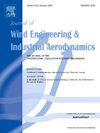基于机器学习的包含多种气象参数的热带气旋风场模型
IF 4.2
2区 工程技术
Q1 ENGINEERING, CIVIL
Journal of Wind Engineering and Industrial Aerodynamics
Pub Date : 2024-11-04
DOI:10.1016/j.jweia.2024.105936
引用次数: 0
摘要
热带气旋(TC)造成的多种危害,如暴雨和强风,每年都会在全球范围内造成巨大的财产损失和人员伤亡。描述风灾发展的热带气旋风场模型是预警实现和相关风险评估的关键。与传统的参数、分析或气象数值模型不同,本研究旨在开发一种基于机器学习的方法,通过纳入多个气象参数来模拟热带气旋风场。风场模型分别考虑了线性和非线性建模,输入数据包括各种气象参数,如表面压力梯度(SPG)、位势(GEO)、边界层高度(BLH)和预报表面粗糙度(FSR)。输出数据是通过图像识别方法提取的区域和中尺度气象分部(RAMMB)的 TC 风场数据,并与欧洲中期天气预报中心(ECMWF)第五代大气再分析数据集 ERA5 的风场同化。在线性模型中,考虑了各种参数组合,但结果总是不尽人意。线性模型的最佳结果是使用所有四个参数组合,均方根误差(RMSE)为 2.60 米/秒,判定系数 R2 值为 0.44。为了提高性能,在训练过程中引入了三种非线性机器学习方法--全连接深度神经网络(FC-DNN)、卷积神经网络(CNN)和变压器。比较三个模型的风场连续性、RMSE 和 R2,发现 Transformer 优于所有其他模型,R2 值为 0.877,RMSE 为 2.23。最后,利用训练有素的 Transformer 模型预测了台风 "勒基马"(1909 年)的风速变化,从而有效地验证了模型。本文章由计算机程序翻译,如有差异,请以英文原文为准。
Machine-learning-based tropical cyclone wind field model incorporating multiple meteorological parameters
Multiple hazards caused by tropical cyclones (TCs), such as heavy rains and strong winds, result in substantial property losses and casualties worldwide each year. TC wind field models, describing the development of the wind hazard, are key within early warning realizations and associated risk assessments. Different to conventional parametric, analytical or meteorological numerical models, this study aims to develop a machine-learning-based approach for modeling TC wind fields by incorporating multiple meteorological parameters. The wind field model considers linear and nonlinear modeling respectively, where the input data includes various meteorological parameters such as surface pressure gradient (SPG), geopotential (GEO), boundary layer height (BLH), and forecast surface roughness (FSR). The output data is the TC wind field data of the Regional and Mesoscale Meteorology Branch (RAMMB) extracted by image recognition method, and assimilated with the wind field from the fifth generation of the European Center for Medium-Range Weather Forecasts (ECMWF) atmospheric reanalysis dataset ERA5. In the linear model, various combinations of parameters are considered, yet always yielding unsatisfactory results. The best results in the linear model were obtained using all four parameter combinations, where the root mean square error (RMSE) was 2.60 m/s and the coefficient of determination value was 0.44. To increase performance, three nonlinear machine learning methods—Fully Connected Deep Neural Networks (FC-DNN), Convolutional Neural Networks (CNN), and Transformer—are introduced to the training process. Comparing the wind field continuity, RMSE and between the three models, it is found that the Transformer outperforms all other models, with value of 0.877 and an RMSE of 2.23. As a final step, the trained Transformer model was used to predict the evolution of wind speed of the Typhoon Lekima (1909), in what could serve as effective model validation.
求助全文
通过发布文献求助,成功后即可免费获取论文全文。
去求助
来源期刊
CiteScore
8.90
自引率
22.90%
发文量
306
审稿时长
4.4 months
期刊介绍:
The objective of the journal is to provide a means for the publication and interchange of information, on an international basis, on all those aspects of wind engineering that are included in the activities of the International Association for Wind Engineering http://www.iawe.org/. These are: social and economic impact of wind effects; wind characteristics and structure, local wind environments, wind loads and structural response, diffusion, pollutant dispersion and matter transport, wind effects on building heat loss and ventilation, wind effects on transport systems, aerodynamic aspects of wind energy generation, and codification of wind effects.
Papers on these subjects describing full-scale measurements, wind-tunnel simulation studies, computational or theoretical methods are published, as well as papers dealing with the development of techniques and apparatus for wind engineering experiments.

 求助内容:
求助内容: 应助结果提醒方式:
应助结果提醒方式:


